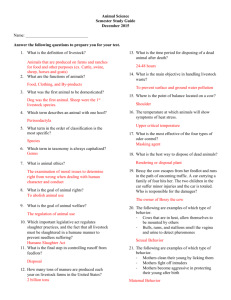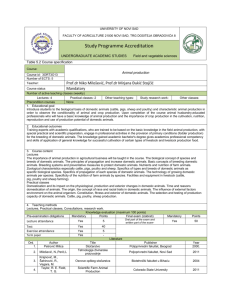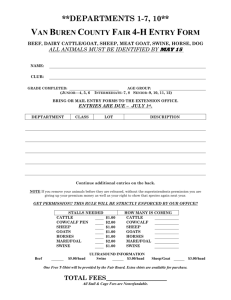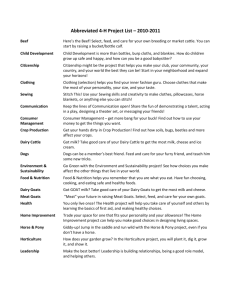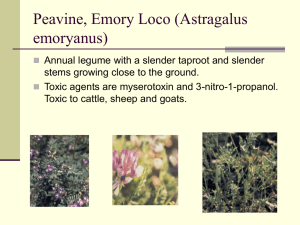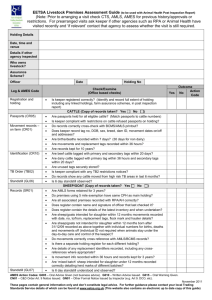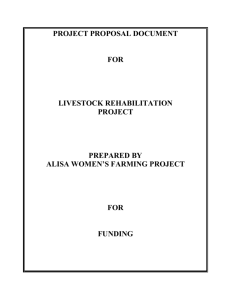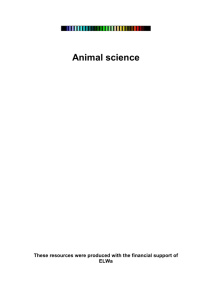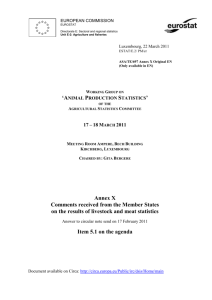Livestock welfare - OTEN
advertisement
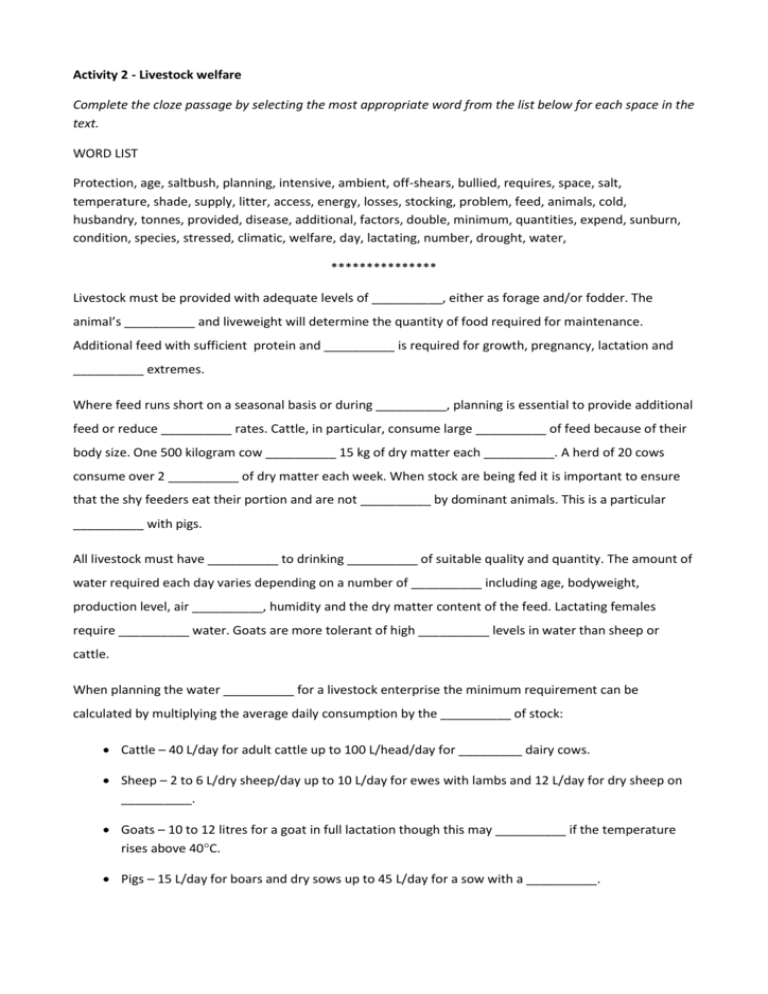
Activity 2 - Livestock welfare Complete the cloze passage by selecting the most appropriate word from the list below for each space in the text. WORD LIST Protection, age, saltbush, planning, intensive, ambient, off-shears, bullied, requires, space, salt, temperature, shade, supply, litter, access, energy, losses, stocking, problem, feed, animals, cold, husbandry, tonnes, provided, disease, additional, factors, double, minimum, quantities, expend, sunburn, condition, species, stressed, climatic, welfare, day, lactating, number, drought, water, *************** Livestock must be provided with adequate levels of __________, either as forage and/or fodder. The animal’s __________ and liveweight will determine the quantity of food required for maintenance. Additional feed with sufficient protein and __________ is required for growth, pregnancy, lactation and __________ extremes. Where feed runs short on a seasonal basis or during __________, planning is essential to provide additional feed or reduce __________ rates. Cattle, in particular, consume large __________ of feed because of their body size. One 500 kilogram cow __________ 15 kg of dry matter each __________. A herd of 20 cows consume over 2 __________ of dry matter each week. When stock are being fed it is important to ensure that the shy feeders eat their portion and are not __________ by dominant animals. This is a particular __________ with pigs. All livestock must have __________ to drinking __________ of suitable quality and quantity. The amount of water required each day varies depending on a number of __________ including age, bodyweight, production level, air __________, humidity and the dry matter content of the feed. Lactating females require __________ water. Goats are more tolerant of high __________ levels in water than sheep or cattle. When planning the water __________ for a livestock enterprise the minimum requirement can be calculated by multiplying the average daily consumption by the __________ of stock: Cattle – 40 L/day for adult cattle up to 100 L/head/day for _________ dairy cows. Sheep – 2 to 6 L/dry sheep/day up to 10 L/day for ewes with lambs and 12 L/day for dry sheep on __________. Goats – 10 to 12 litres for a goat in full lactation though this may __________ if the temperature rises above 40C. Pigs – 15 L/day for boars and dry sows up to 45 L/day for a sow with a __________. __________ from climatic extremes is vital for all stock. Each __________ has a thermoneutral zone. If the __________ temperature falls below or rises above this zone the animal must __________ energy to keep warm or cool. The effects of __________ stress are exacerbated by wind chill and wet coats or fleeces. Newborn and young animals, stock in poor body __________ and sheep and goats __________ are particularly vulnerable. Dairy cattle can become heat __________ in hot, humid conditions leading to production __________ and lowered fertility. Pigs kept outdoors must be provided with __________ and shelter as they are susceptible to both cold and heat stress as well as __________. There are additional welfare requirements for stock housed in __________ situations. All food and water must be __________ and the animals kept in an adequately clean environment. Air contaminants such as dust and noxious chemicals should be kept to a __________. Sufficient __________ to move, stand and lie down must be available and the stock monitored frequently for injury or __________. A number of __________ practices are carried out routinely to maintain the __________ of livestock and to manage the herd. Good __________ and an understanding of stock handling techniques will ensure that stock are moved and handled with a minimum of stress to both the __________ and the handlers. Livestock welfare - answers Livestock must be provided with adequate levels of feed, either as forage and/or fodder. The animal’s age and liveweight will determine the quantity of food required for maintenance. Additional feed with sufficient protein and energy is required for growth, pregnancy, lactation and climatic extremes. Where feed runs short on a seasonal basis or during drought, planning is essential to provide additional feed or reduce stocking rates. Cattle, in particular, consume large quantities of feed because of their body size. One 500 kilogram cow requires 15 kg of dry matter each day. A herd of 20 cows consume over 2 tonnes of dry matter each week. When stock are being fed it is important to ensure that the shy feeders eat their portion and are not bullied by dominant animals. This is a particular problem with pigs. All livestock must have access to drinking water of suitable quality and quantity. The amount of water required each day varies depending on a number of factors including age, bodyweight, production level, air temperature, humidity and the dry matter content of the feed. Lactating females require additional water. Goats are more tolerant of high salt levels in water than sheep or cattle. When planning the water supply for a livestock enterprise the minimum requirement can be calculated by multiplying the average daily consumption by the number of stock: Cattle – 40 L/day for adult cattle up to 100 L/head/day for lactating dairy cows. Sheep – 2 to 6 L/dry sheep/day up to 10 L/day for ewes with lambs and 12 L/day for dry sheep on saltbush. Goats – 10 to 12 litres for a goat in full lactation though this may double if the temperature rises above 40C. Pigs – 15 L/day for boars and dry sows up to 45 L/day for a sow with a litter. Protection from climatic extremes is vital for all stock. Each species has a thermoneutral zone. If the ambient temperature falls below or rises above this zone the animal must expend energy to keep warm or cool. The effects of cold stress are exacerbated by wind chill and wet coats or fleeces. Newborn and young animals, stock in poor body condition and sheep and goats off-shears are particularly vulnerable. Dairy cattle can become heat stressed in hot, humid conditions leading to production losses and lowered fertility. Pigs kept outdoors must be provided with shade and shelter as they are susceptible to both cold and heat stress as well as sunburn. There are additional welfare requirements for stock housed in intensive situations. All food and water must be provided and the animals kept in an adequately clean environment. Air contaminants such as dust and noxious chemicals should be kept to a minimum. Sufficient space to move, stand and lie down must be available and the stock monitored frequently for injury or disease. A number of husbandry practices are carried out routinely to maintain the welfare of livestock and to manage the herd. Good planning and an understanding of stock handling techniques will ensure that stock are moved and handled with a minimum of stress to both the animals and the handlers.

